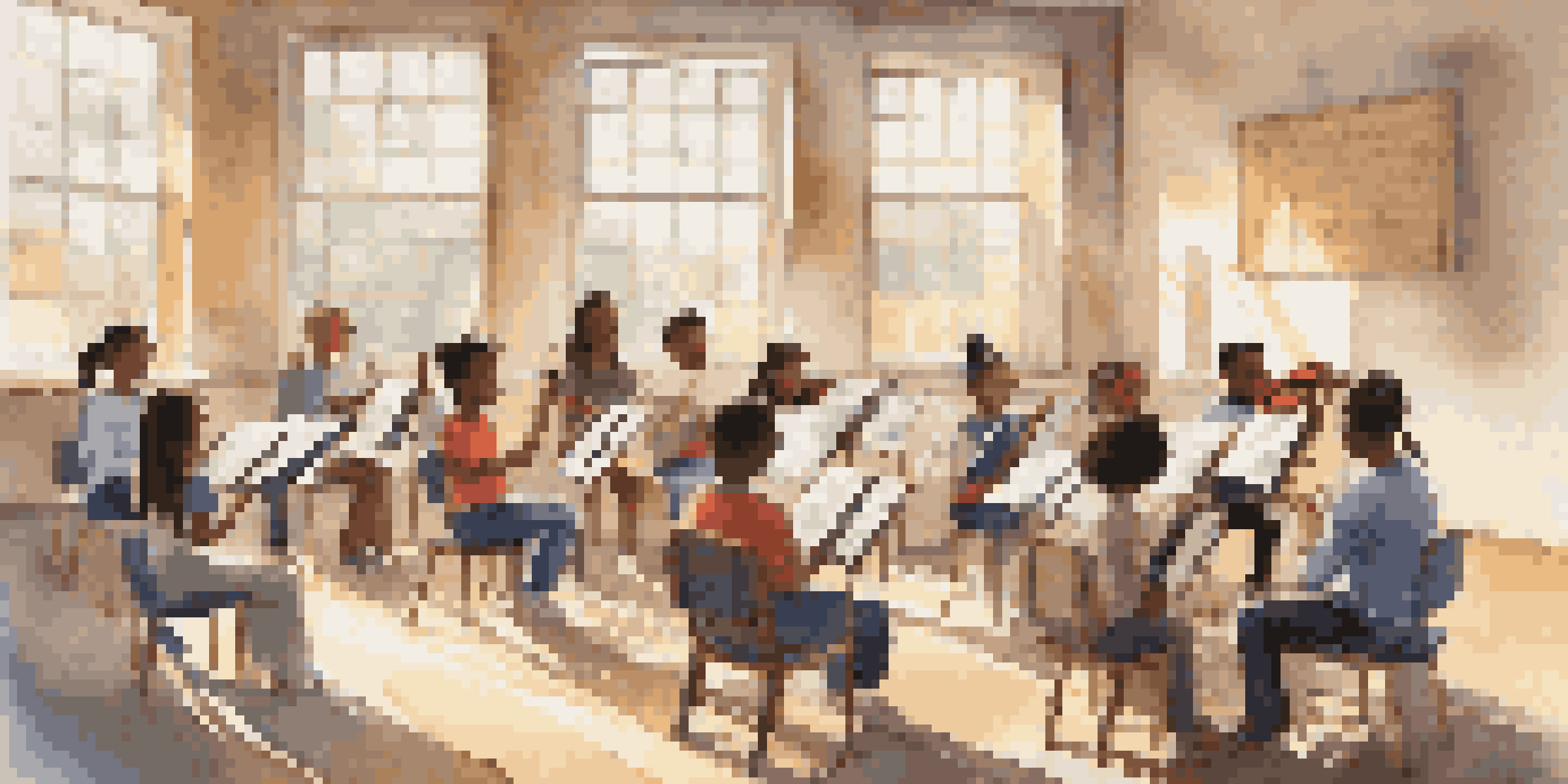Vocal Pedagogy: Techniques for Teaching Singing Effectively

Understanding Vocal Anatomy is Key to Teaching Singing
To teach singing effectively, it's crucial to understand vocal anatomy. The vocal cords, diaphragm, and resonating chambers all play significant roles in sound production. By knowing how these elements work together, teachers can better guide students in proper technique and avoid harmful practices.
The voice is the most powerful instrument of all, and it is the one that connects us to our inner selves and to each other.
For instance, explaining the function of the diaphragm helps students realize how important breath support is for singing. When students understand that their breath is like fuel for their voice, they're more likely to engage in exercises that strengthen their breath control. This foundational knowledge sets the stage for more advanced techniques.
Moreover, discussing vocal health and anatomy can demystify the singing process for students. When they feel informed about how their bodies work, they often feel more empowered to explore their vocal potential and take responsibility for their singing journey.
Establishing a Positive Learning Environment
Creating a positive learning environment is essential for effective vocal pedagogy. Students flourish when they feel safe and supported, allowing them to take risks and express themselves. A nurturing atmosphere promotes confidence, which is key in developing vocal skills.

In practice, this can involve praising effort as much as achievement. Encouraging students to focus on their progress rather than perfection can alleviate performance anxiety. By celebrating small victories, teachers can motivate students to keep pushing their boundaries.
Understand Vocal Anatomy for Success
Knowing vocal anatomy, including the diaphragm and vocal cords, empowers teachers to guide students in developing healthy singing techniques.
Additionally, fostering open communication encourages students to share their thoughts and feelings about their singing. This dialogue not only strengthens the teacher-student bond but also gives teachers insight into what methods resonate best with their students.
Incorporating Breathing Techniques for Better Control
Breathing is the backbone of singing, and incorporating breathing techniques into lessons is vital. Teaching students how to control their breath can vastly improve their vocal performance. Techniques such as diaphragmatic breathing help singers manage their airflow and sustain notes longer.
To sing well is to be in harmony with oneself, and to teach singing is to guide others into that harmony.
One effective exercise is having students lie on their backs with a book on their stomachs. As they breathe in, they should see the book rise, promoting engagement of the diaphragm. This visual cue reinforces the concept that proper breath support is about expanding the lower lungs rather than simply filling the chest.
As students become more comfortable with these techniques, they can apply their breath control to various singing styles. This versatility not only enhances their vocal range but also prepares them for diverse musical genres.
Engaging Students with Vocal Exercises and Warm-Ups
Vocal exercises and warm-ups are essential for preparing students to sing. These activities not only help protect the voice but also enhance vocal flexibility and strength. Incorporating a variety of exercises keeps lessons fresh and engaging.
For example, starting with simple sirens or lip trills can warm up the vocal cords without straining them. As students progress, gradually introducing scales or arpeggios can challenge their range and pitch accuracy. This progression helps build a solid foundation for more complex pieces.
Create a Supportive Learning Space
Fostering a positive and nurturing environment encourages students to take risks and build confidence in their vocal abilities.
Moreover, making these exercises fun can enhance student engagement. Singing games or creative vocal challenges can transform routine warm-ups into enjoyable activities, fostering a love for singing while honing their skills.
Cultivating Musicality Through Ear Training
Musicality is as important as technical skill in singing, and ear training is a powerful tool for developing this aspect. Helping students identify pitch, rhythm, and harmony enhances their overall musical understanding. Through ear training, singers learn to listen critically, which is essential for improving their performances.
Simple exercises like singing back intervals or clapping rhythm patterns can sharpen a student's musical ear. These activities serve to reinforce the connection between hearing and singing, making it easier for students to tackle complex pieces. Additionally, this skill can boost their confidence in ensemble settings.
Ultimately, cultivating musicality through ear training allows singers to express themselves more fully. When they trust their instincts and understand the music, they can bring more emotion and depth to their performances.
Tailoring Teaching Methods to Individual Needs
Every student is unique, and tailoring teaching methods to their individual needs is crucial for effective vocal pedagogy. Understanding a student's learning style, vocal abilities, and personal goals allows teachers to provide personalized instruction. This customized approach can significantly enhance a student's development.
For instance, some students may respond better to visual aids, while others thrive on auditory cues. By incorporating various teaching styles, such as demonstrations or interactive exercises, teachers can engage students in ways that resonate with them. This adaptability fosters a more productive learning experience.
Integrate Technology in Training
Utilizing technology like apps and recording software enhances vocal training by providing instant feedback and expanding learning resources.
Additionally, regular feedback and assessments help track progress and adjust techniques accordingly. By maintaining open lines of communication, teachers can ensure that students feel seen and supported in their unique vocal journeys.
Incorporating Technology in Vocal Training
Technology has transformed many aspects of teaching, and vocal pedagogy is no exception. Tools such as recording software, apps, and online resources can enhance the learning experience. These technologies allow students to track their progress and gain a deeper understanding of their vocal development.
For instance, using a pitch-tracking app can provide instant feedback on a student's intonation. This immediate insight enables singers to make adjustments in real time, reinforcing concepts learned during practice. Additionally, recording lessons can help students review their progress and identify areas for improvement.

Moreover, online platforms can expand access to resources and expert guidance. By integrating technology into vocal training, teachers can create a more dynamic and engaging learning environment that caters to today's tech-savvy students.
Encouraging Performance Experience for Growth
Performance experience is a vital component of vocal pedagogy that fosters growth and confidence. Providing opportunities for students to perform, whether in recitals, competitions, or informal settings, helps them apply their skills in real-world situations. This practical experience can significantly enhance their stage presence and comfort while singing.
Additionally, performance preparation encourages students to set goals and work diligently towards them. This process not only builds their technical skills but also nurtures their emotional resilience. Learning to handle pre-performance nerves is a valuable life skill that extends beyond the realm of music.
Ultimately, encouraging performance experience enriches the learning journey. It turns abstract concepts into tangible achievements, allowing students to celebrate their hard work and dedication while nurturing their passion for singing.